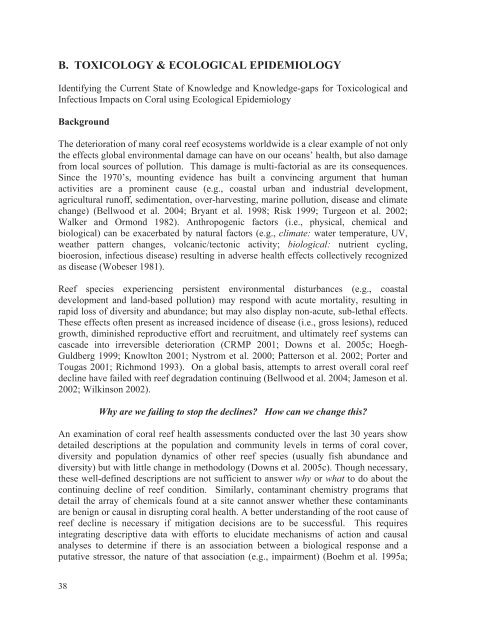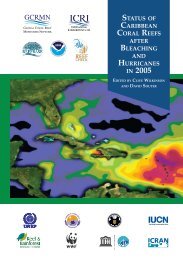Coral Health and Disease in the Pacific: Vision for Action
Coral Health and Disease in the Pacific: Vision for Action
Coral Health and Disease in the Pacific: Vision for Action
You also want an ePaper? Increase the reach of your titles
YUMPU automatically turns print PDFs into web optimized ePapers that Google loves.
B. TOXICOLOGY & ECOLOGICAL EPIDEMIOLOGYIdentify<strong>in</strong>g <strong>the</strong> Current State of Knowledge <strong>and</strong> Knowledge-gaps <strong>for</strong> Toxicological <strong>and</strong>Infectious Impacts on <strong>Coral</strong> us<strong>in</strong>g Ecological EpidemiologyBackgroundThe deterioration of many coral reef ecosystems worldwide is a clear example of not only<strong>the</strong> effects global environmental damage can have on our oceans’ health, but also damagefrom local sources of pollution. This damage is multi-factorial as are its consequences.S<strong>in</strong>ce <strong>the</strong> 1970’s, mount<strong>in</strong>g evidence has built a conv<strong>in</strong>c<strong>in</strong>g argument that humanactivities are a prom<strong>in</strong>ent cause (e.g., coastal urban <strong>and</strong> <strong>in</strong>dustrial development,agricultural runoff, sedimentation, over-harvest<strong>in</strong>g, mar<strong>in</strong>e pollution, disease <strong>and</strong> climatechange) (Bellwood et al. 2004; Bryant et al. 1998; Risk 1999; Turgeon et al. 2002;Walker <strong>and</strong> Ormond 1982). Anthropogenic factors (i.e., physical, chemical <strong>and</strong>biological) can be exacerbated by natural factors (e.g., climate: water temperature, UV,wea<strong>the</strong>r pattern changes, volcanic/tectonic activity; biological: nutrient cycl<strong>in</strong>g,bioerosion, <strong>in</strong>fectious disease) result<strong>in</strong>g <strong>in</strong> adverse health effects collectively recognizedas disease (Wobeser 1981).Reef species experienc<strong>in</strong>g persistent environmental disturbances (e.g., coastaldevelopment <strong>and</strong> l<strong>and</strong>-based pollution) may respond with acute mortality, result<strong>in</strong>g <strong>in</strong>rapid loss of diversity <strong>and</strong> abundance; but may also display non-acute, sub-lethal effects.These effects often present as <strong>in</strong>creased <strong>in</strong>cidence of disease (i.e., gross lesions), reducedgrowth, dim<strong>in</strong>ished reproductive ef<strong>for</strong>t <strong>and</strong> recruitment, <strong>and</strong> ultimately reef systems cancascade <strong>in</strong>to irreversible deterioration (CRMP 2001; Downs et al. 2005c; Hoegh-Guldberg 1999; Knowlton 2001; Nystrom et al. 2000; Patterson et al. 2002; Porter <strong>and</strong>Tougas 2001; Richmond 1993). On a global basis, attempts to arrest overall coral reefdecl<strong>in</strong>e have failed with reef degradation cont<strong>in</strong>u<strong>in</strong>g (Bellwood et al. 2004; Jameson et al.2002; Wilk<strong>in</strong>son 2002).Why are we fail<strong>in</strong>g to stop <strong>the</strong> decl<strong>in</strong>es? How can we change this?An exam<strong>in</strong>ation of coral reef health assessments conducted over <strong>the</strong> last 30 years showdetailed descriptions at <strong>the</strong> population <strong>and</strong> community levels <strong>in</strong> terms of coral cover,diversity <strong>and</strong> population dynamics of o<strong>the</strong>r reef species (usually fish abundance <strong>and</strong>diversity) but with little change <strong>in</strong> methodology (Downs et al. 2005c). Though necessary,<strong>the</strong>se well-def<strong>in</strong>ed descriptions are not sufficient to answer why or what to do about <strong>the</strong>cont<strong>in</strong>u<strong>in</strong>g decl<strong>in</strong>e of reef condition. Similarly, contam<strong>in</strong>ant chemistry programs thatdetail <strong>the</strong> array of chemicals found at a site cannot answer whe<strong>the</strong>r <strong>the</strong>se contam<strong>in</strong>antsare benign or causal <strong>in</strong> disrupt<strong>in</strong>g coral health. A better underst<strong>and</strong><strong>in</strong>g of <strong>the</strong> root cause ofreef decl<strong>in</strong>e is necessary if mitigation decisions are to be successful. This requires<strong>in</strong>tegrat<strong>in</strong>g descriptive data with ef<strong>for</strong>ts to elucidate mechanisms of action <strong>and</strong> causalanalyses to determ<strong>in</strong>e if <strong>the</strong>re is an association between a biological response <strong>and</strong> aputative stressor, <strong>the</strong> nature of that association (e.g., impairment) (Boehm et al. 1995a;38
















